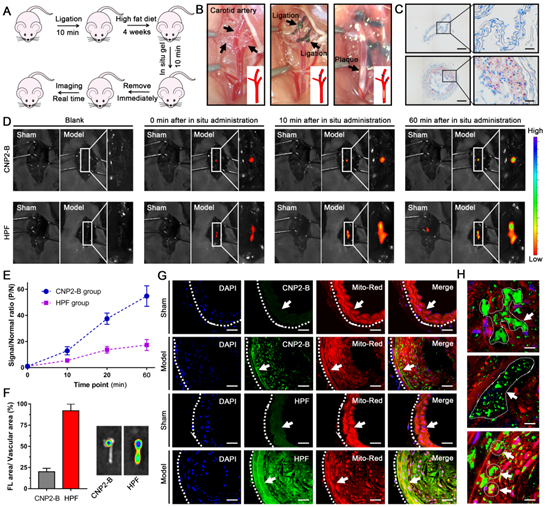An “AND” Molecular Logic Gate as a Super-enhancers for De Novo Designing Activatable probe and its Application in Atherosclerosis Imaging
21 March,2023
Fluorescence imaging can detect the development and changes of target analytes at the molecular level in a non-invasive way, and then explain the physiological and pathological process of disease. The development of fluorescent probes provides a simple and powerful tool for people to better understand and diagnose diseases. However, it is still a challenging problem to design fluorescent probes with high selectivity and high signal-to-noise ratio to deal with complex biological environments. The development of an activable fluorescent probe with ultra-high fluorescence enhancement factor (F/F0) is conducive to improving the signal-to-noise ratio in vivo imaging, thus improving the quality of disease diagnosis.
Based on the above research background, associate researcher Jinrong Zheng, Mangmang Sang and professor Cuilian Dai et al. from Institute of Cardiovascular Diseases, Affiliated Cardiovascular Hospital, Xiamen University designed a "AND" molecular logic gate as a super enhancer, used to design an activated fluorescent probe to obtain ultra-high F/F0, which shows great application potential in fluorescence imaging of atherosclerotic plaque. Relevant research results were published in the international top journal Advanced Science (IF=17.521).

Research point 1:
The probe CNP2-B was obtained by using coumarin derivatives with lipid-responsive properties as fluorescent groups and modified borate esters as peroxynitrite (ONOO -) response groups. In the presence of lipid mimetics, the F/F0 of CNP2-B for ONOO - is up to 2600, which proved that the mode of taking lipid as controllable input and analyte as variable input can be used as an enhancer for highly sensitive analysis of analyte.

Research point 2:
"AND" logic probe has more powerful recognition ability and accuracy than single response probe. Stimulate macrophages with LPS, PMA, ox-LDL, etc. to make macrophages in different phenotypes, after responding to ONOO−. The CNP2-B probe is transferred into the fat droplet and emits strong light. CNP2-B can specifically sort out the phenotype of foam cells stimulated by ox LDL without interference of other inflammatory phenotypes.

Research point 3:
Atherosclerotic plaque has a large number of foam cells and lipid accumulation, and is in a chronic inflammatory state for a long time. The CNP2-B probe can accurately delineate the plaque position on the carotid artery, which has higher selectivity than the single-response probe.

Mangmang Sang, Yibo Huang, Lu Wang, Lei Chen, Nawsherwan, Gang Li, Yan Wang, Xiu Yu, Cuilian Dai, Jinrong Zheng. An “AND” Molecular Logic Gate as a Super-Enhancers for De Novo Designing Activatable Probe and Its Application in Atherosclerosis Imaging[J]. Advanced Science. 2023. DOI: 10.1002/advs.202207066.https://onlinelibrary.wiley.com/doi/10.1002/advs.202207066
share

